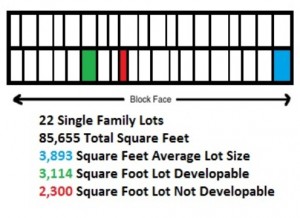Small-Lot Legislation
Finalizing Small Lot Regulation
During the summer of 2012, our City Council passed emergency legislation to modify the development standards governing undersized lots in single family zones. The interim measures were adopted to address neighborhood concerns that development under the old standards was sometimes out of character with surrounding conditions and inconsistent with the policy intent of allowing infill development on undersized lots. The changes made affect development standards for “historic lots” under Section 23.44.010.B.1.d of the code. Smart Growth Seattle (SGS) supports the interim measures as a pragmatic response to real concerns neighbors expressed about the size and scale of new housing development on smaller lots.
As currently written, the interim measures preserve the exception for some historic lots, but impose new development standards consistent with the principles of smart growth. Following is a summary of the new standards:
- Limits on the application of the lot area exception provided for historic lots of record to those lots with an area of at least 50 percent of the general minimum requirement for the zone;
- An end to the use of historic tax records as a basis for qualifying for lot area exceptions; and
- Development of lots with an area of between 50 and 75 percent of the general minimum lot area of the zone (lots between 2,500 and 3,750 square feet in an SF 5000 zone)with a height limit of 22 feet, the same height and floor area that would be allowed for a detached accessory dwelling units on a lot of the same dimensions.
Why Do We Support This Legislation?
This legislation creates predictable, and appropriately scaled urban density1allowing more housing on a smaller footprint, and it supports sustainable development2 by allowing new, smaller, more energy efficient homes. The legislation contributes to economic opportunity3, creating new construction jobs and tax revenue. By creating predictable and planned development on smaller lots, this legislation substantially addresses the important concerns of neighbors but also maintains a local tradition of architectural diversity4in our single-family neighborhoods, respecting basic development patterns there without discriminating against diverse designs. Housing choice5 is supported by this legislation by enabling homebuilders to meet the demand for smaller-scale single-family homes in the city.
Further Improvements For Smart Growth
In addition to the new standards for historic lots, SGS proposes new development standards for Section 23.44.010.B.1.a, commonly known as the “75/80 Rule”. In some neighborhoods, lots exist that are less than 75% of the minimum of the zone, but make sense for development because they conform to the size of the neighboring lots. SGS believes that allowing development on these lots would balance the need for more infill opportunities with keeping the character of surrounding conditions.
- Modify the 75/80 rule to allow development of housing on lots that are 80% of the average lot size of a block face regardless of size. (i.e. if the average size of the lots on a block is 4000 square feet, then the minimum required size for development would be 3200 square feet);
Specifically, the proposed standards would:
- Limit the height of houses built on qualifying lots as follows:
- 22 feet for lots that are 60% or less of the zone (i.e. lots 3000 square feet or less in an SF 5000 zone would be restricted to 22 feet);
- 25 feet for lots that are less than 75% of the zone (i.e. lots 3000 to 3750 square feet in an SF 5000 zone would be limited to 25 feet)
New 80% Rule and Neighborhood Impact
The city benefits from the proposed 80% Rule because it allows infill housing in a predictable manner for both neighbors and homebuilders. Most neighborhoods have irregular but generally consistent lot sizes. For example, take this block of lots zoned Single Family 5000. Lots in this neighborhood require a minimum lot size of 5000 feet, but the existing lots are much smaller. The average lot size of all the lots facing one street is 3,893 square feet while the smallest lot on the block is 2,300 square feet. The proposed 80% Rule would allow a house to be built on a lot that is 3,114 square feet, or about 700 square feet less than the average lot. Because the lot is smaller than 3750 square feet, the new standards would impose a height restriction of 25 feet to insure that the new house would be in character with the surrounding conditions.
Smart Growth on a Consistent Scale
These careful adjustments of lot requirements in single-family neighborhoods give more clarity to the process for building on small lots. The new proposal would clarify the existing code and allow building of new homes on lots smaller than the minimum lot area requirements (9600, 7200, and 5000 square feet respectively) and establish the “80 Percent Rule.”
Adoption of the 80 Percent Rule would allow housing to be built on lots in a single-family zone unless it that are 80 percent of average lot on the block. For example, if a property owner wants to build a new home on an existing lot, and the average of all the lots on her block is 5000 square feet, her lot must be at least 4000 square feet.
The 80 Percent Rule gives the City a new tool so that new development will be easier to predict for property owners, neighbors, and developers.
—————————————————————————–
1 http://www.sightline.org/research/compact-neighborhoods/
2 http://www.usgbc.org/Docs/Archive/MediaArchive/310_Prahl_PA772.pdf
3 http://www.usgbc.org/ShowFile.aspx?DocumentID=6435
4 http://agbeat.com/real-estate-news-events/2012-home-design-trends-focus-on-the-family/


